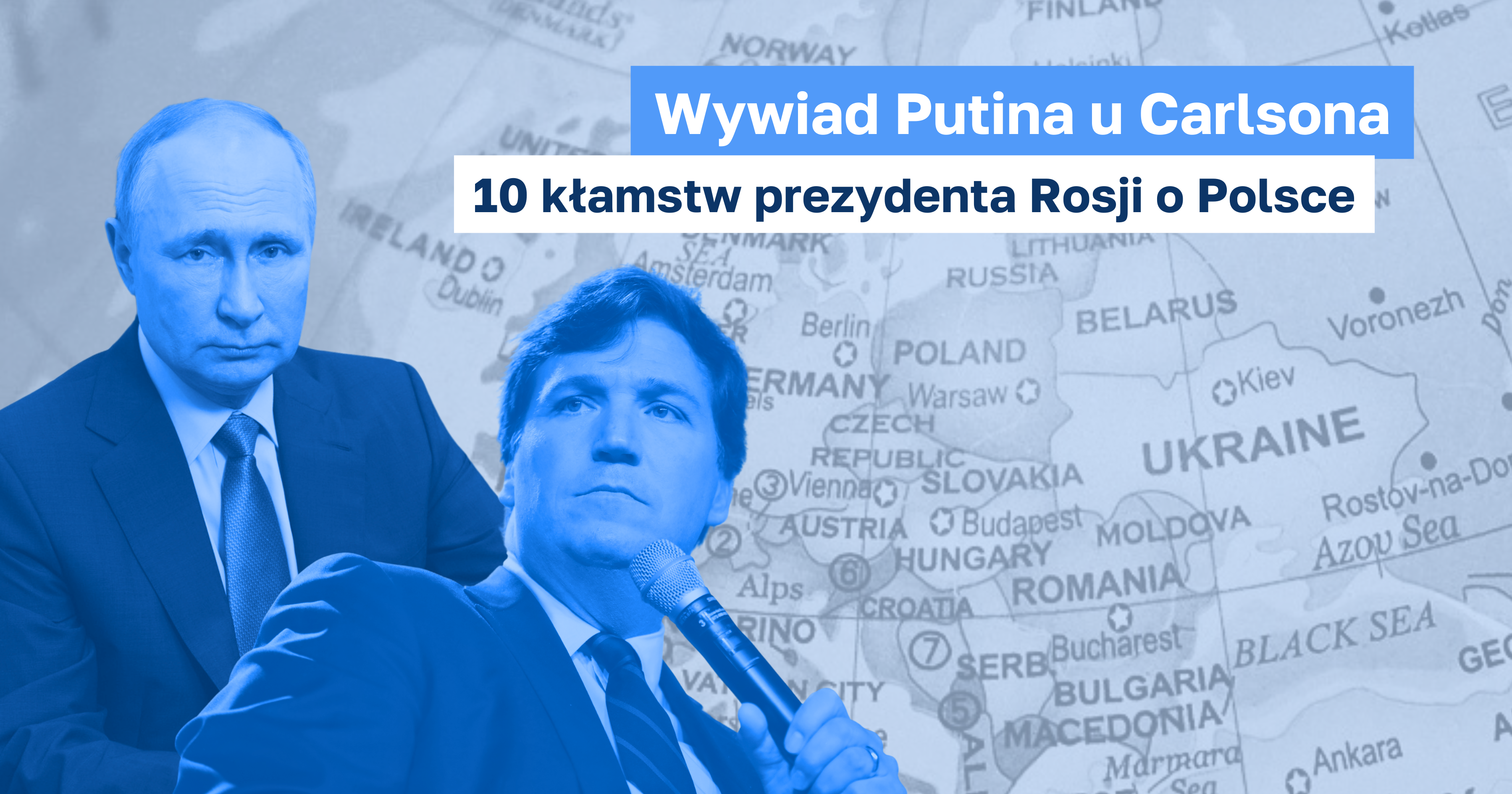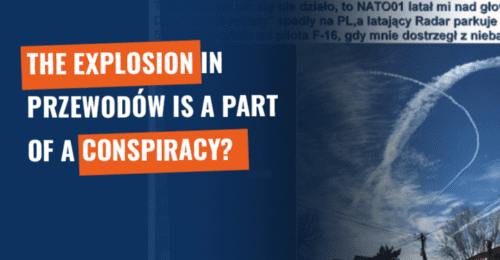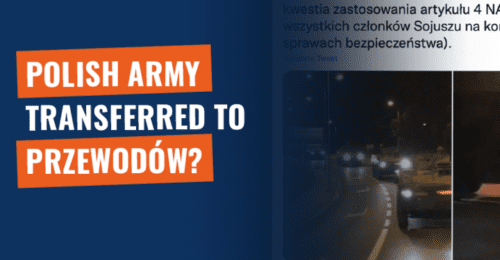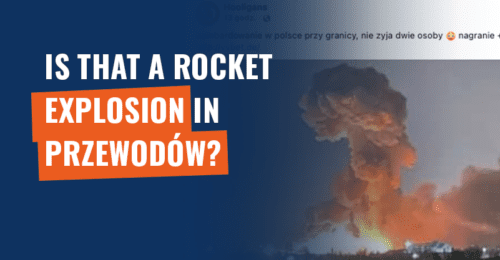We debunk false information that appears on social media and websites. We verify the most harmful examples of disinformation by referring to credible sources.
Putin and Carlson – we verify lies about Poland
We debunk false claims made by Vladimir Putin regarding Poland.

fot. Kremlin.ru / Wikimedia Commons / CC BY 4.0 / Modyfikacje: Demagog fot. Gage Skidmore from Peoria, AZ, United States of America / Wikimedia Commons / CC BY-SA 2.0 / Modyfikacje: Demagog
Putin and Carlson – we verify lies about Poland
We debunk false claims made by Vladimir Putin regarding Poland.
FAKE NEWS IN A NUTSHELL
- American journalist Tucker Carlson’s interview with Vladimir Putin has been published online. During the meeting, several themes emerged about the history of Europe, Ukraine, and Russia. The interview appeared to be a space that was used propaganda-wise by the Russian government to reinforce Russia’s goals during the ongoing invasion of Ukraine.
- In this analysis, we examine the credibility of statements made by Vladimir Putin who manipulated information about contemporary Poland and its history. The Russian president’s message was said to imply that, among other things, Poland allegedly collaborated with Hitler in the 20th century [recording time 14:25]. In the contemporary context, it was pointed out, for example, that Poland closed the flow of gas through the Yamal-Europe gas pipeline in 2022 [recording time 01:14:38]. This information is not factually correct [1, 2].
On Thursday, 8 February 2024, American journalist Tucker Carlson‘s interview with Russian President Vladimir Putin was broadcast. The media was in an uproar [1, 2, 3]. Many commentaries [1, 2, 3] indicated that the material would be used for propaganda — especially in the context of justifying actions in Ukraine. In his words, the Russian president repeatedly referred to Poland. Much controversy was aroused by, among other things, his statements in which he alleged that Poland had collaborated with Adolf Hitler [recording time 14:25].
We collected Vladimir Putin’s statements from the interview and decided to check the Russian president’s verifiable claims about Poland, including its history and present day.
1. Poland collaborated with Hitler? This is the biggest fake news coming from the interview
From the footage, we learn that the Russian president believes that Poland had a history of cooperation with Adolf Hitler. “In 1939, after Poland cooperated with Hitler – it did collaborate with Hitler, you know – Hitler offered Poland peace and a treaty of friendship and alliance” [recording time 12:50]. Contrary to the claims made in the film in question, Polish foreign policy prior to the Second World War did not seek a military alliance with Adolf Hitler.
In 1934, Poland and Germany signed a non-aggression pact, which guaranteed a peaceful settlement of disputes over, among other things, territory. This led to a temporary improvement in relations between the states, which, however, collapsed again in 1939 with the Third Reich’s territorial demands on the Republic of Poland.
As we read in the article “The Polish-German Non-Aggression Pact of 1934 — origins and overview of the provisions”, Germany’s plan was never to make a lasting peace with Poland: “Germany’s intentions, however, were not sincere. They only intended to lull the vigilance of the Second Polish Republic and give themselves time to prepare for war.” (p. 86).
The pact was eventually broken by the German side in April 1939 (p. 92). In August of the same year, the Third Reich and the USSR signed the Molotov-Ribbentrop Pact, which provided, among other things, for the division of spheres of influence in Central and Eastern Europe between the two states.
How was Poland’s foreign policy shaped before the Second World War?
After the death of Jozef Pilsudski in 1935, Polish foreign policy implemented by Jozef Beck was conducted based on a ‘policy of balance‘.
The Polish Institute of National Remembrance (IPN) defines it as maintaining “»an equal distance « from the USSR and from the Germans, with the complete exclusion of being bound by an alliance either with the Third Reich against Moscow or with Moscow against the Third Reich”.
Poland’s policy of balance has sometimes been criticised for mainly ‘balancing’ relations with Germany rather than the USSR (p. 29). However, this was due to a greater fear of German aggression than of Soviet aggression, not to a desire for exclusive cooperation with the Third Reich (pp. 29-30).
2. Poles took part in the division of Czechoslovakia?
In his statement, Vladimir Putin also added that the Poles “collaborated with Hitler and engaged together in the partitioning of Czechoslovakia” [recording time 13:38]. Historical facts do not support these words.
In September 1938, representatives of the governments of Germany, Italy, Britain, and France concluded the Munich Agreement. It authorized Germany to annex part of Czechoslovakia. The Republic of Poland was not a party to the treaty. The Polish government took advantage of the fact that the document had been signed to take its own action — to occupy Zaolzie, part of Cieszyn Silesia. However, one cannot speak of Polish-German cooperation here.
3. Poland “fell victim” to its policy towards Czechoslovakia?
Later in the interview, the Russian president said: “By the way, the USSR […] asked Poland’s permission to transit its troops through the Polish territory to help Czechoslovakia. But the then Polish foreign minister said that if the Soviet planes flew over Poland, they would be downed over the territory of Poland. […] the war began, and Poland fell prey to the policies it had pursued against Czechoslovakia, as under the well-known Molotov-Ribbentrop Pact, part of that territory, including western Ukraine, was to be given to Russia. Thus Russia, which was then named the USSR, regained its historical lands” [recording time 15:02].
By uttering these words, the Russian President seeks to justify the armed aggression against Poland during the Second World War. This pushes the responsibility for Russian actions onto the lack of willingness and cooperation on the part of the Polish Republic, which was supposed to have cooperated with Adolf Hitler. This is not true.
As already mentioned, as part of the ‘policy of balance‘, the representatives of the Polish Republic did not enter into alliances with either the Nazi German or Russian sides, which could have targeted the Third Reich or the USSR.
Russian aggression against Ukraine cannot be justified by history
Poland’s refusal to accept German territorial claims, or the admission of Soviet troops who wanted to go to the aid of Czechoslovakia (p.11), cannot explain the brutal occupation of its territory. In the same way, Ukraine’s failure to make concessions to Crimea and Donbas cannot explain the invasion of their territories by Russian troops.
In the context of Czechoslovakia, it should be remembered that the USSR decided not to send troops there not only because Poland did not agree to it, but also because of the attitude of France and England (pp. 16-17).
The USSR initially wanted to defend Czechoslovakia militarily together with other democratic states to stop Adolf Hitler. France and England, however, preferred to make concessions (pp. 16-17).
4. Has Poland closed off the flow of gas through the Yamal-Europe pipeline?
Vladimir Putin also referred to the contemporary situation regarding gas in Europe and its flow through Poland. As he explained: “There is another route through Poland, called Yamal-Europe, which also allows for a large flow. Poland has closed it, but Poland pecks from the German hand, it receives money from pan-European funds, and Germany is the main donor to these pan-European funds. Germany feeds Poland to a certain extent. And they closed the route to Germany. Why? I don’t understand.” [recording time 01:14:38].
Russia used gas supply issues as a tool for political pressure against European countries. The gas pipeline contract was supposed to end at the end of 2022. In practice, Poland was forced by Russian actions to terminate the contract with Russia earlier. This happened because, at the beginning of 2022, gas payments in roubles were demanded. If Poland had agreed to such a solution, it would have violated the sanctions, that were introduced by the European Union.
Vladimir Putin, in his statement, tried to blame Poland for this state of affairs, without mentioning that it was Russia that decided to cut off the gas until it was paid in roubles before the end of the current contract in April 2022. Meanwhile, as the then Minister of Climate and Environment Anna Moskwa explained in 2022:
“The agreement [on gas — Demagog] was an international agreement, so the relevant note on the matter was provided by the Polish Ministry of Foreign Affairs. The document was sent on Monday. When Russia, by cutting us off from supplies, de facto violated the provisions of the agreement, the Polish government considered that, due to the violation of its essential terms, it was no longer valid.”
5. How many mercenaries from Poland are currently fighting in Ukraine against Russia?
The interview also contains information about foreign mercenaries who are now expected to fight in Ukraine: “There are mercenaries [in Ukraine – Demagog’s note] from the United States there. The biggest number of mercenaries comes from Poland, with mercenaries from the United States in second place, and mercenaries from Georgia in third place” [recording time 1:10:09]. There is not enough evidence to confirm the Russian President’s words.
According to the findings of the fact-checking website StopFake.org, by March 2022, some 20,000 foreign volunteers had expressed a desire to fight on the side of Ukraine (p. 12). Exact figures as to how many of these people have joined the Ukrainian army are not provided by the Ukrainian government, mainly for security reasons.
Russian mercenary figures not borne out by facts
In June 2022, the Russian Ministry of Defence published data according to which a total of almost 7,000 foreign mercenaries were to fight in Ukraine as of 24 February 2022. By contrast, in July 2023, it was reported that some 11,000 foreign soldiers had arrived in Ukraine since the start of the ‘special operation’, and at that point, more than 2,000 were expected to remain in the country.
Confirmation of these figures, however, is sought in vain in both Polish and foreign sources. In April 2022, Marcin Ociepa, then deputy head of the Polish Ministry of Defence (MON), in an interview with radio RMF FM stressed that he could not disclose the exact numbers of those who had decided to leave to fight on the side of Ukraine for security reasons. He added that exact statistics cannot be determined because some people may have left without the knowledge of the Ministry of Defence.
OTHER FALSE INFORMATION ABOUT POLAND
6. Was it Poles who convinced Ukrainians that they were a separate ethnic group from the Russians?
In the material, Vladimir Putin states that it was the Poles who instilled in the Ukrainians that they were a separate ethnic group from the Russians. In the video, we hear: “During decades, the Poles were engaged in the »Polonization « of this part of the population: they introduced their language there, tried to entrench the idea that this population was not exactly Russians, that because they lived on the fringe (u kraya) they were »Ukrainians«. Originally, the word »Ukrainian « meant that a person was living on the outskirts of the state, near the fringe, or was engaged in border service. It didn’t mean any particular ethnic group” [recording time 7:09].
It is true that the original meaning of the word ‘Ukraine’ was borderlands, which lay in the border areas. In the past, the territories of present-day Ukraine were most often referred to as ‘Rus’ (p. 10). However, this does not mean that as a result of the actions of the Poles, Ukrainians began to see themselves as a separate ethnic group.
The beginnings of the formation of Ukrainian national consciousness – when and where?
In the book by historian Professor Wladyslaw A. Serczyk “History of Ukraine”, we read that the process of formation of national distinctiveness and the Ukrainian language gained momentum already in the period after the district disintegration of Kievan Rus (p. 57). By contrast, the concept of Ukraine as a territory inhabited by people who differed in language and customs from their neighbors in the public consciousness began to appear as early as around the 14th and 15th centuries (p. 58). Contrary to Putin’s claims, the Poles were not responsible for these processes.
In this context, it is also worth mentioning that in the times of the First Polish Republic, the Poles recognized the national separateness of the inhabitants of today’s Ukraine. This can be evidenced, among other things, by the Treaty of Hadiach of 16 September 1658, according to which it was planned to create the Polish-Lithuanian Commonwealth with the Principality of Rus as its third constituent state.
Polonisation of the Ukrainian population in the First Polish Republic did occur but was limited to the elite and was voluntary (pp. 309-310), in contrast to the mass and violent Russification of Ukrainians in the 19th century.
Polish-Ukrainian relations during the Second Polish Republic
During the Second Polish Republic, however, Polish-Ukrainian relations were difficult, and the long-lasting border conflict between the two nations contributed to this. As Prof. Maciej Marszał wrote, part of the Polish political elite (including Josef Pilsudski) sought a Polish-Ukrainian agreement. However, due to the discord within the Polish elite on the one hand and the intransigence of Ukrainian nationalists on the other, we did not live in peace with each other (p. 14).
For example, there were disputes over education in Poland. Grabski’s reform restricted teaching in Ukrainian. Importantly, however, the use of this language in schools was not banned. The idea was to introduce bilingual teaching.
Another example of the Polish-Ukrainian conflict is the fact that Ukrainian nationalists were imprisoned in the Polish detention camp at Bereza Kartuska.
These facts, however, bear no relation to the years of forced Russification of Ukraine under Russian annexation, or the leading to the deaths of some 4 million Ukrainians as a result of the Great Ukrainian Famine of 1932-1933 caused by the Soviet authorities.
7. How did the incorporation of the “Old Russian lands” into the Russian Empire proceed?
In the interview, Vladimir Putin said: “Russia would not agree to admit them [borderlands – Demagog’s note] straight away, assuming that the war with Poland would start. Nevertheless, in 1654, the Pan-Russian Assembly of top Clergy and Landowners headed by the Tsar (Zemsky Sobor), which was the representative body of power of the Old Russian state, decided to include a part of the Old Russian lands into the Moscow Kingdom” [recording time 10:33].
However, Vladimir Putin in the interview does not add that the territories in question originally belonged to Kievan Rus, which was conquered in the 13th century by the Mongols.
Immediately before the outbreak of the war between Poland and Russia in 1654, the borderlands in question belonged to the Polish-Lithuanian Commonwealth. Their occupation was therefore an interference in the affairs of the functioning of the Polish-Lithuanian state. It was Russia that declared war, and in the case of the Polish-Lithuanian Commonwealth it was a defensive war.
As a result of the 1648-1655 war between the Poles and the Cossacks who lived in the Polish Republic, Bohdan Chmielnicki — the leader of the Cossack uprising — wanted to turn to Russia for protection (p. 134). Consequently, in 1654, the Cossacks concluded the Pereiaslav Agreement, which was intended to allow the Cossacks to retain their freedoms and autonomy after incorporation into the Russian state. At the same time, it involved the incorporation of territories and the dependence of the local population in matters of international politics (p. 136).
8. Putin manipulates historical events to establish influence
During the interview, Vladimir Putin repeatedly referred to the struggle for the restoration of historical territories. In the interview, we hear that: “As expected, the war with Poland began. It lasted 13 years, and then in 1654, a truce was concluded. And 32 years later, I think, a peace treaty with Poland, which they called »eternal peace«, was signed. And these lands, the whole left bank of the Dnieper, including Kiev, went to Russia, and the whole right bank of the Dnieper remained in Poland” [recording time 10:33].
According to the Russian president, the war with Poland in the 17th century involved the ‘return of the lands to Russia’, but — again — no mention was made of the fact that the lands originally belonged to Kievan Rus‘, which historically was not a Russian state. On the other hand, it gave rise to the modern Russian, Belarusian, and Ukrainian states. Modern Russia can trace its origins primarily to the Principality of Moscow (p. 49), which for a long period of its existence until 1505 did not control Kyiv, but only part of the Ukrainian lands (comparison of maps before and after the rule of Ivan III: 1 and 2).
A settlement with the Cossacks in 1654 was followed by a war between Poland and Russia, which lasted until 1667. The Truce of Andrusovo (later transformed into the Perpetual Peace in 1686) was then concluded. It resulted in a division of territory, with Russia retaining the Smolensk, Sverska, and Chernihiv territories, left-bank Ukraine, and Kyiv. Poland got the right-bank Ukraine.
The Cossack movement was not homogeneous and not everyone liked being incorporated into Russia, which gave rise to numerous conflicts between the local population and the Tsarist authorities in the future (pp. 137-138).
9. Did Poles persecute Ukrainians during the Polish-Lithuanian Commonwealth?
Vladimir Putin went on to say: “But due to the historical development, these territories [the territories of modern Ukraine — Demagog’s note] were part of the Polish-Lithuanian Commonwealth – Poland, where Ukrainians were persecuted and treated quite brutally as well as were subject to cruel behavior. There were also attempts to destroy their identity. All this remained in the memory of the people” [recording time 56:23]. This issue requires clarification.
Professor Mirosław Nagielski in his book ‘Under a Common Sky: Ethnic Groups of the Commonwealth of Poland and Lithuania‘ mentions that, as a consequence of the Union of Lublin in 1569, the lands of Southern Ruthenia, among others, were incorporated into the Polish Crown. As the author writes: “The Ruthenians were therefore admitted to the Crown’s citizens as »equals to equals«” (s. 56).
Admittedly, over time, Cossacks also sought nobility privileges, which was opposed by the rest of the Commonwealth’s elite (p. 62). However, this does not mean that the very existence of the Ruthenians was not recognized, or that the Ruthenian elites were subjected to forced and brutal Polonisation.
The Polish-Cossack conflict
The Cossack uprisings and their subsequent, sometimes brutal suppression arose not from resistance to Polonisation, but from the unequal treatment of the Cossack elite vis-à-vis the Polish and Lithuanian elites. The instrumental handling of the Cossacks was also significant – their assistance in wars was used (p. 60), but the obligations arising from this assistance were not fulfilled.
It was also outrageous to force Cossacks into serfdom when they preferred to remain free men. Yes, Bohdan Chmielnicki raised slogans for the defense of the Orthodox Church and called for the expulsion of the ‘Lakhs’, but not because the Poles were fighting ‘Ukrainianness’ (p. 64).
Importantly, conflicts with Cossacks were caused not only by Poles but also by Lithuanian and Ruthenian large landowners. In the Kyiv region in 1648, newcomers from Poland accounted for only 13 percent of landowners (p. 65).
10. Did the Second Polish Republic receive the right bank of the Dnieper in 1921?
The Russian president went on to explain that allegedly: “After the 1917 Revolution, the Bolsheviks sought to restore the statehood, and the Civil War began, including the hostilities with Poland. In 1921, peace with Poland was proclaimed, and under that treaty, the right bank of the Dnieper River once again was given back to Poland” [recording time 12:00].
It is not true that the right bank of the Dnieper was returned to Poland in 1921 after peace was declared with the Bolsheviks. Firstly, the borders of the Second Polish Republic, which was established after the end of the First World War, never reached the banks of this river or the areas in its close vicinity.
From 1922, after the Bolshevik Revolution, the lands around the Dnieper were within the borders of the USSR. On the map below, which depicts the Second Polish Republic from this period, you can see that the south-eastern edge of Poland reaches a small piece of the Dniester (next to the San).

Image: Rowanwindwhistler / Wikimedia Commons / CC BY-SA 3.0 / https://creativecommons.org/licenses/by-sa/3.0 / Modifications: Demagog
Conclusion — an interview or space for propaganda dissemination?
An American journalist’s interview with Vladimir Putin proved to be a convenient formula for sowing disinformation and Russian propaganda. The American journalist did not verify the information during the interview. Consequently, as Maria Domanska of the Centre for Eastern Studies (OSW) assesses: “The interview bears the hallmarks of a wide-ranging propaganda operation by Russia, linking internal and external objectives to it”.
In this analysis, we verified 10 statements by Vladimir Putin — each of which contained misleading or false information about Poland and its historical fate. At the same time, it must be remembered that there was much more false news in the conversation itself, which journalists and fact-checkers from all over the world are engaged in verifying [1, 2, 3, 4]. Verified information, however, will not reach everyone who was exposed to the interview itself.
*If you find an error, highlight it and enter Ctrl + Enter






